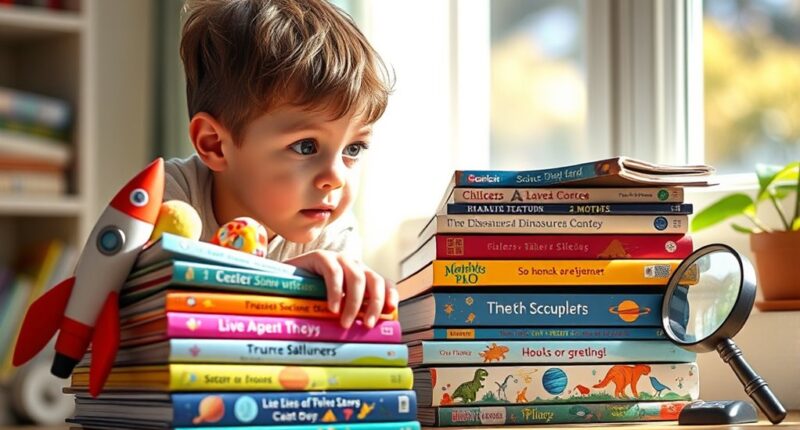If you’re looking for books that spark curiosity and imagination in kids, I highly recommend “Awesome Science Experiments for Kids” for hands-on fun, and “National Geographic Kids Why?” for fascinating answers to questions. “The Fascinating Science Book for Kids” offers engaging facts, while “National Geographic Little Kids First Big Book of Science” serves as a charming introduction to science. These selections create excitement around learning and set the stage for future explorations. You’ll discover even more great choices ahead!
Key Takeaways
- Engaging storytelling and vibrant illustrations in books like “The 13 Science Mysteries” captivate young readers and make complex concepts fun.
- Hands-on projects in “Awesome Science Experiments for Kids” promote curiosity and allow children to explore STEM/STEAM fields effectively.
- Comprehensive resources like “Britannica All New Kids Encyclopedia” encourage critical thinking with a wide range of topics and visually appealing design.
- Accessible experiments using common household items in “Kitchen Science Experiments” make learning exciting and encourage frequent experimentation at home.
- Books like “National Geographic Kids Why?” provide answers to kids’ questions, fostering a love for learning and encouraging independent exploration.
Awesome Science Experiments for Kids: 100+ Fun STEM Projects
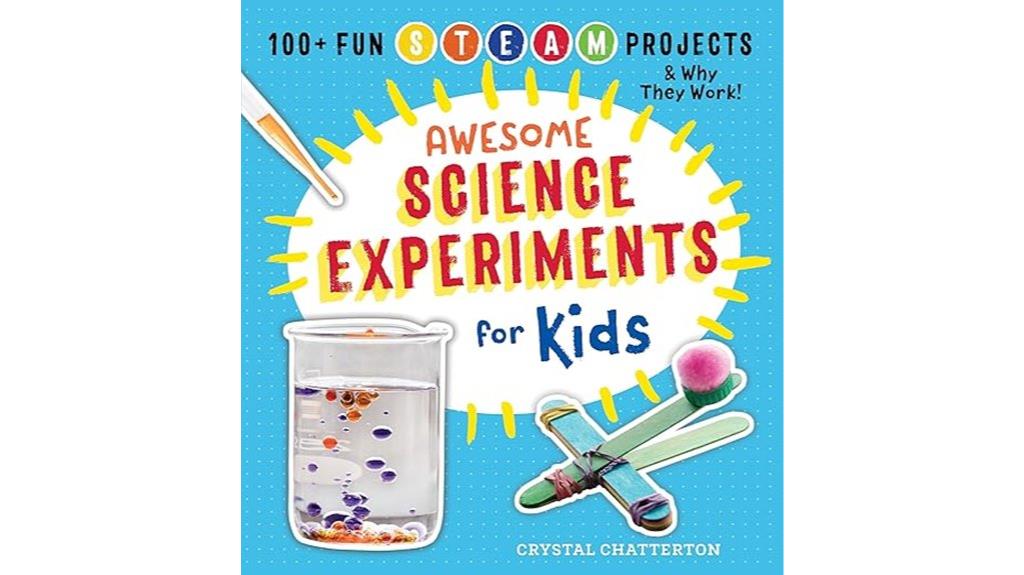
If you’re looking for a way to ignite your child’s curiosity about science, “Awesome Science Experiments for Kids: 100+ Fun STEM Projects” is the perfect choice. This book offers over 100 hands-on projects that not only educate but also entertain kids of all ages. I love how it covers various subjects like chemistry, physics, and biology, appealing to different interests. The clear instructions foster understanding, making each experiment accessible. I’ve found it’s a fantastic way for families to bond while learning together, especially during tough times. You’ll definitely see your child’s curiosity and love for science grow with this book!
Best For: Families, educators, and young explorers looking to engage children in fun and educational science activities.
Pros:
- Engaging hands-on projects that cover various scientific disciplines, sparking interest in STEM/STEAM.
- Clear instructions and explanations enhance children’s understanding of scientific concepts.
- Suitable for different ages, making it a great resource for family bonding and homeschooling.
Cons:
- Some experiments may require specific supplies that aren’t commonly found at home.
- Planning ahead is necessary to ensure all materials are available, which can be a minor inconvenience.
- A few projects may be more challenging than others, potentially requiring adult supervision or assistance.
Science Knowledge Encyclopedia for Children: Collection of 6 Books (Box Set)
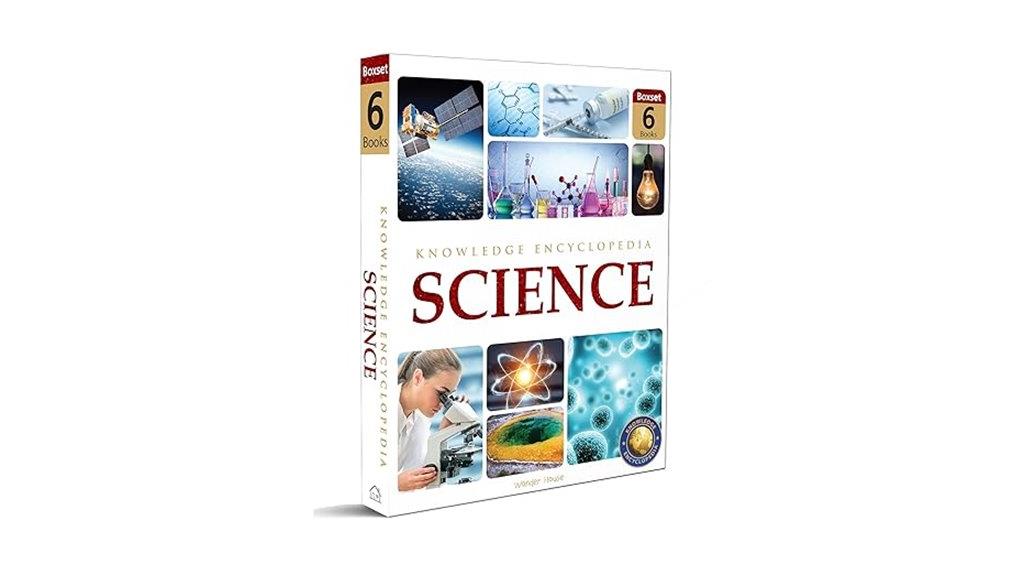
The “Science Knowledge Encyclopedia for Children: Collection of 6 Books (Box Set)” is perfect for young learners enthusiastic to explore the wonders of science. My grandsons received this box set for Christmas, and they absolutely loved it! The range of subjects sparked their curiosity, although I noticed it lacked pronunciation notes for some complex topics. While the books provide basic information, some details could be deeper. The colorful prints are engaging, making it visually appealing. Just a heads up, I received a used set with a damaged box, so it’s wise to check before purchasing. Overall, it’s a decent collection!
Best For: Young learners who are curious about science and enjoy exploring a variety of subjects.
Pros:
- Engaging and colorful prints that capture children’s attention.
- A wide range of science topics that spark curiosity.
- Suitable for foundational knowledge in science.
Cons:
- Lacks pronunciation notes for complex subjects.
- Some users may find the content too basic or lacking in detail.
- Possible issues with receiving a used product or damaged packaging.
National Geographic Kids Why?: Over 1,111 Answers to Everything
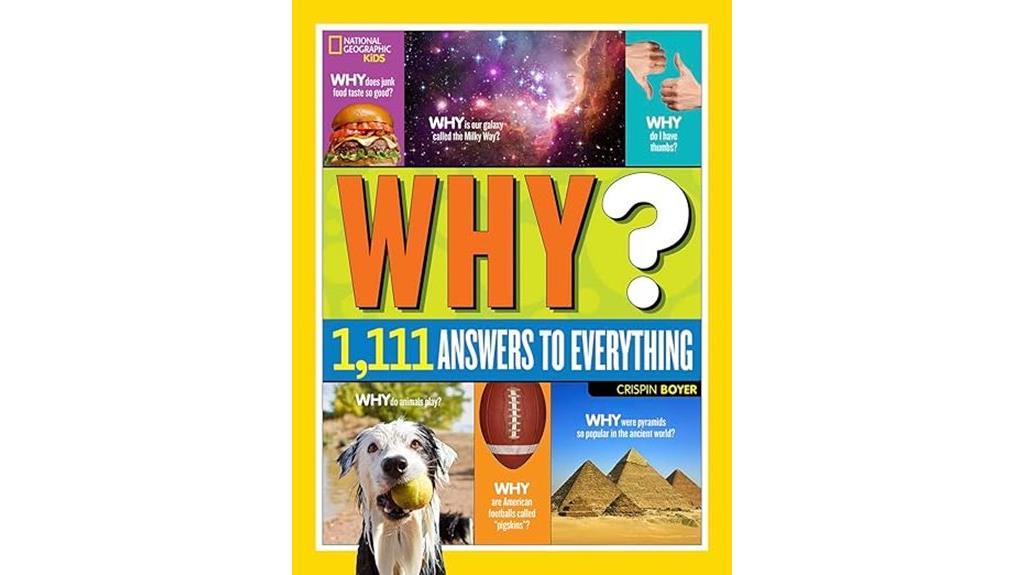
Curious kids aged 4 to 13 will find “National Geographic Kids Why?: Over 1,111 Answers to Everything” an irresistible treasure trove of knowledge. This book captivates young minds with vibrant illustrations and fascinating facts that spark endless questions. It encourages children to think critically and engage in discussions, reinforcing the importance of independent thought. My kids couldn’t put it down! The sturdy hardback format guarantees it survives even the most enthusiastic readers. With a wide range of topics, this book is not just educational but also a fun way to explore the world together. It’s truly a must-have for curious families!
Best For: Curious children aged 4 to 13 who enjoy exploring a wide range of topics through engaging illustrations and fun facts.
Pros:
- Encourages critical thinking by prompting children to ask questions and engage in discussions.
- Durable hardback format ensures the book withstands enthusiastic use by young readers.
- Wide variety of topics makes it a fun and educational resource for both kids and parents.
Cons:
- Some customers reported issues with the condition of the book upon arrival.
- May not hold the attention of older children or those outside the 4 to 13 age range.
- Limited depth on certain topics could leave some curious minds wanting more detailed information.
The Fascinating Science Book for Kids: 500 Amazing Facts
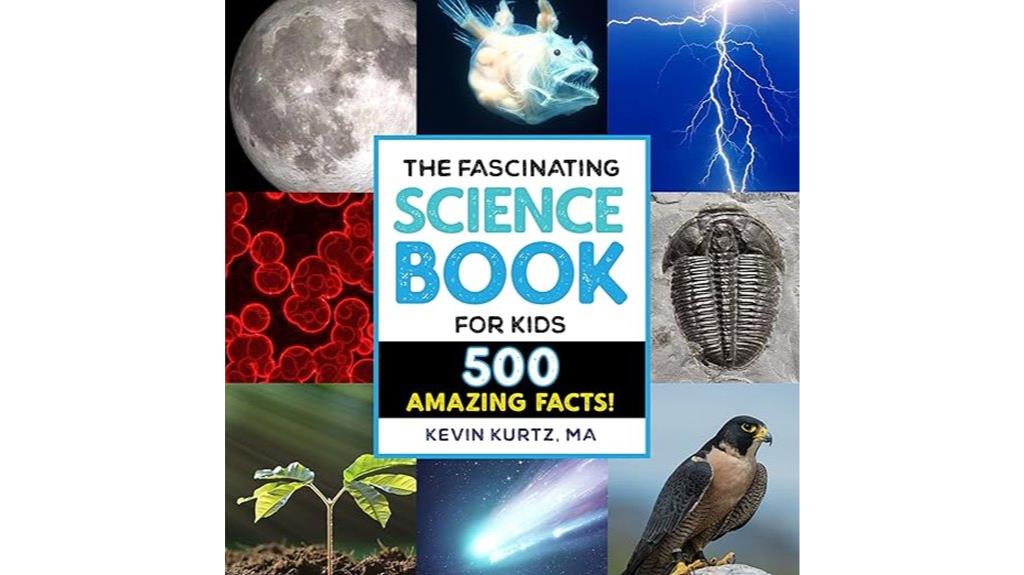
Looking for a perfect science book for a 6 to 10-year-old? “The Fascinating Science Book for Kids: 500 Amazing Facts” is an incredible choice that sparks curiosity and engages young minds. My 9-year-old son loves sharing these fun facts with his friends, and the vibrant illustrations keep him captivated. It’s a fantastic gift for my science-mad granddaughter and perfect for special occasions. I’ve even found it enjoyable as a parent, appreciating how it encourages learning. This book isn’t just for kids; it’s a delightful experience for the whole family, making science truly fascinating and fun!
Best For: Children aged 6 to 10 years old who are curious about science and enjoy learning through engaging facts and visuals.
Pros:
- Packed with 500 fascinating facts that promote fun learning and curiosity.
- Full of vibrant illustrations that enhance visual engagement for young readers.
- Suitable as a gift for various occasions, appealing to both kids and parents alike.
Cons:
- May not hold the attention of older children or teens.
- Some kids might prefer interactive science activities over reading facts.
- Limited depth on scientific concepts, focusing primarily on fun facts rather than detailed explanations.
National Geographic Little Kids First Big Book of Science
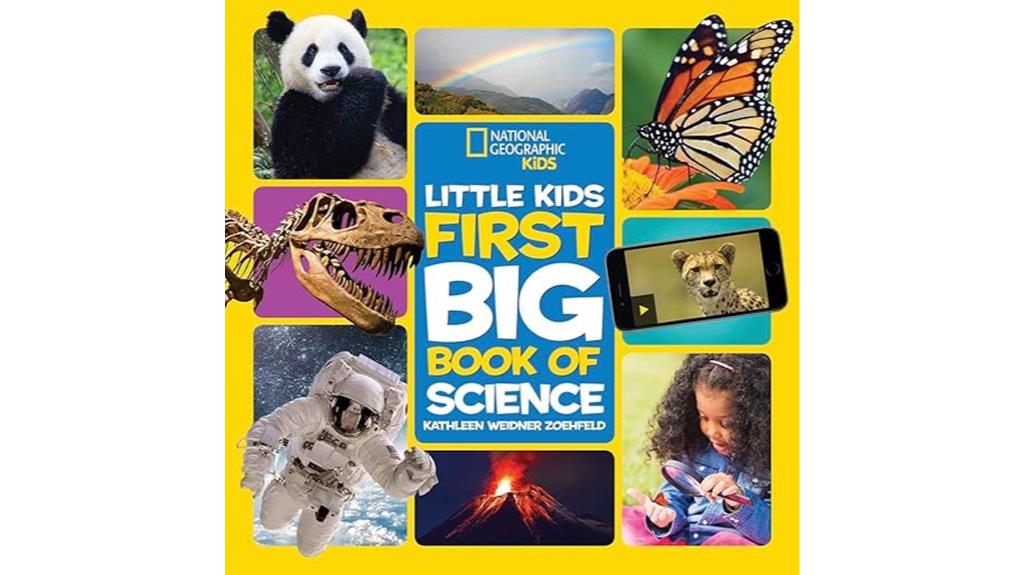
National Geographic Little Kids First Big Book of Science stands out as an exceptional choice for preschoolers and young grade-schoolers enthusiastic to explore the wonders of science. Its colorful pages and stunning illustrations capture attention while providing a solid introduction to various scientific concepts. I love how the simple experiments encourage curiosity and keep kids engaged. It’s perfect for reading together, enhancing both learning and bonding time. Many parents, like me, appreciate how it grows with our children, making it a fantastic gift for budding scientists. Pair it with a telescope, and you’ve got a memorable science-themed present!
Best For: Preschoolers and young grade-schoolers who are eager to explore and learn about science through engaging visuals and simple experiments.
Pros:
- Excellent photography and illustrations enhance the learning experience.
- Encourages exploration and curiosity, making it an enjoyable gift for children.
- Grows with children, providing valuable information as they advance in reading and comprehension.
Cons:
- Some vocabulary may require explanation, which could be challenging for younger readers.
- May be too simple for advanced readers, potentially limiting engagement.
- Ideal for reading together, not designed for independent reading at early stages.
Awesome Science Experiments for Kids: 100+ Fun STEM/STEAM Projects

Designed for young explorers enthusiastic to plunge into the world of science, “Awesome Science Experiments for Kids: 100+ Fun STEM/STEAM Projects” is the perfect choice for parents and educators seeking engaging, hands-on activities. This book offers over 100 fun projects spanning chemistry, physics, and biology, making it a fantastic resource for diverse interests. I love how each experiment includes clear instructions that promote critical thinking and creativity. Families can bond while learning, using common household items for most activities. With its educational value, this book truly sparks curiosity and inspires a lifelong love for science in kids of all ages!
Best For: Parents and educators looking for engaging, hands-on science activities for kids of all ages.
Pros:
- Encourages critical thinking and creativity through hands-on experiments.
- Covers a wide range of topics in chemistry, physics, and biology to appeal to diverse interests.
- Utilizes mostly common household items, making projects accessible and easy to execute.
Cons:
- Some experiments may require specific supplies not typically found at home.
- Planning ahead is necessary to ensure all materials are available, which can be a minor inconvenience.
- A few projects may be more complex, requiring adult supervision or assistance.
The 13 Science Mysteries
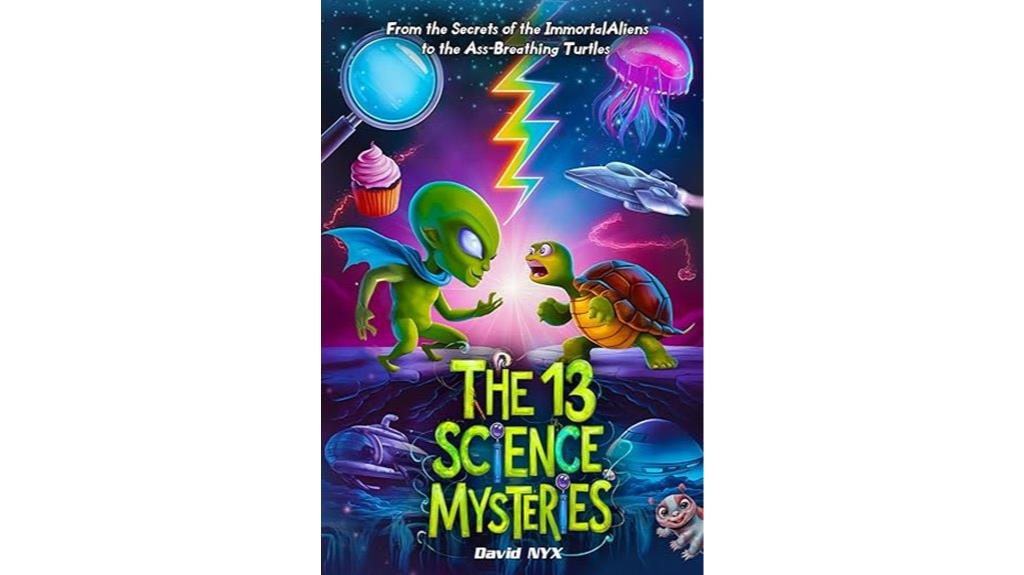
If you’re searching for an engaging way to spark curiosity in young readers aged 9-12, “The 13 Science Mysteries” is a fantastic choice. This book features adventure stories narrated by kids, introducing quirky characters like Dr. Puddlewick and Captain Wobbleton. Each tale presents strange scenarios—think rainbow lightning and jellyfish that can reverse their age—keeping readers hooked. What’s great is that after every story, science facts follow, making complex concepts fun and easy to grasp. With short chapters and lively illustrations, it’s perfect for bedtime or quick learning breaks, ensuring both kids and parents enjoy this enthralling journey through science.
Best For: Young readers aged 9-12 who are curious about science and enjoy engaging stories.
Pros:
- Engaging storytelling that makes learning science fun and relatable for kids.
- Diverse science topics that capture the imagination and introduce various scientific phenomena.
- Short chapters and lively illustrations that make it easy to digest and perfect for bedtime reading.
Cons:
- Some readers may desire more visuals or diagrams to enhance understanding of complex concepts.
- The quirky characters and stories may not appeal to all children, particularly those who prefer traditional narratives.
- Limited depth on scientific topics may leave advanced readers wanting more detailed explanations.
The Mysteries of the Universe: DK Children’s Anthologies
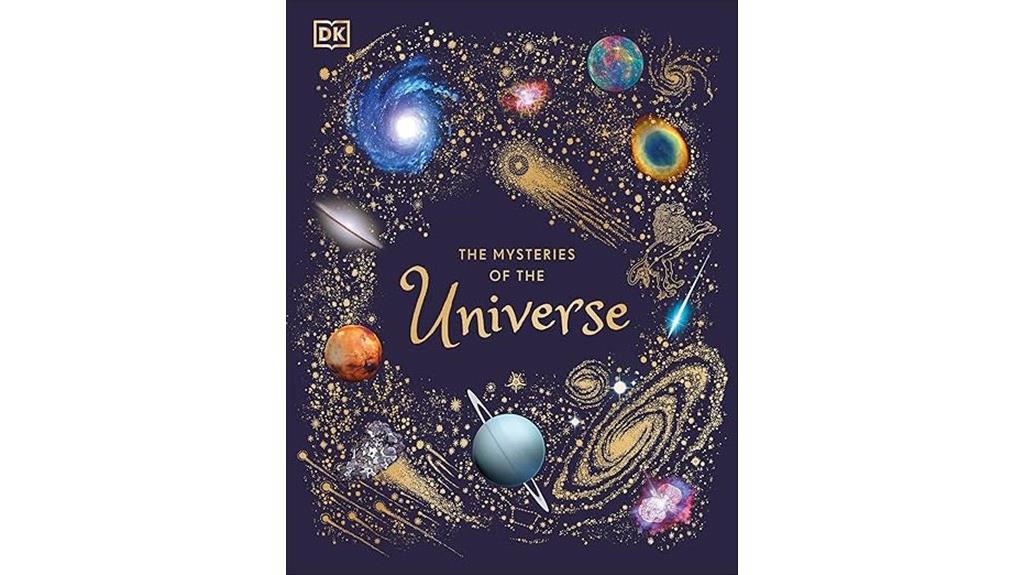
For curious young minds enthusiastic to explore the cosmos, “The Mysteries of the Universe: DK Children’s Anthologies” stands out as an engaging choice. This book presents astronomy concepts logically, making it accessible for ages 3 to 8. Each celestial object is beautifully illustrated with vibrant images that captivate and spark curiosity. I love how it avoids irrelevant myths, focusing instead on clear, concise explanations. The layout is easy to navigate, allowing kids to find information effortlessly. It’s affordable too, making it a fantastic addition to any young reader’s collection. Just be cautious about packaging to guarantee it arrives in perfect condition!
Best For: This book is best for curious young minds aged 3 to 8 who are eager to explore the cosmos through engaging and accessible astronomy concepts.
Pros:
- Clear and concise explanations of celestial objects without irrelevant mythology, making learning straightforward.
- Stunning visuals that captivate young readers and enhance their interest in space.
- User-friendly layout that allows easy navigation for children and encourages independent exploration of information.
Cons:
- Some users reported issues with damaged copies upon arrival, highlighting the need for better packaging.
- The content, while suitable for ages 3 to 8, may not challenge older children or adults who seek more in-depth astronomy knowledge.
- Limited interactive elements that might engage readers further, such as activities or questions.
Britannica All New Kids Encyclopedia: What We Know & What We Dont
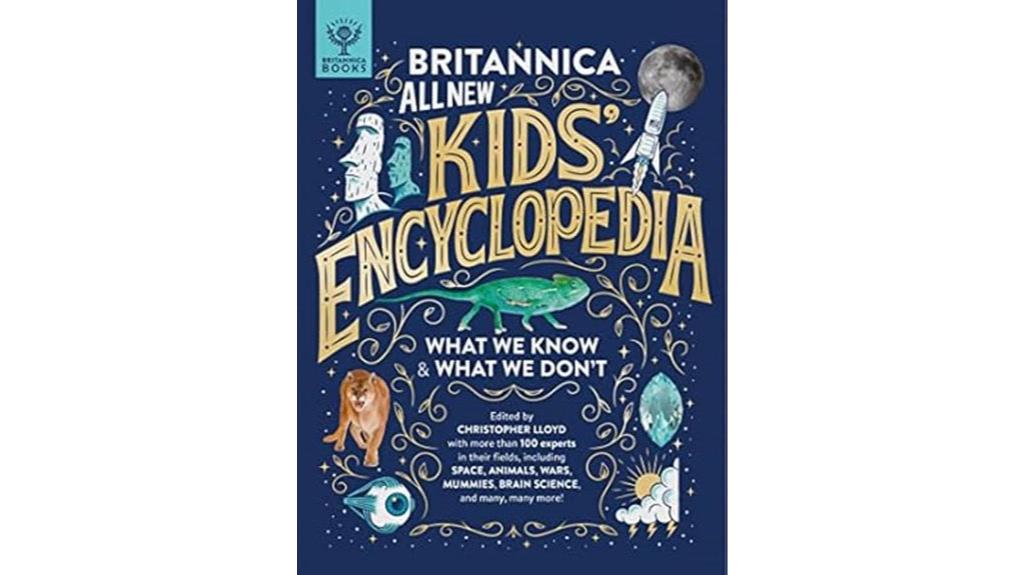
The Britannica All New Kids Encyclopedia stands out as the ideal choice for curious young minds enthusiastic to explore the world around them. It sparks curiosity and critical thinking, covering topics from animals to outer space. Brightly colored pages and eye-catching illustrations keep kids engaged, while the chapter organization makes exploration easy. I’ve seen how this book transforms reading habits; even reluctant readers find joy in its content. Its sturdy hardcover guarantees it withstands frequent use, making it a valuable resource. Whether for bedtime reading or casual exploration, it’s a versatile addition to any child’s library that fosters a love for learning.
Best For: Curious young learners eager to explore a wide range of topics and enhance their reading skills.
Pros:
- Engages children with vibrant illustrations and a visually appealing design that maintains interest.
- Encourages critical thinking and curiosity through a variety of topics, from animals to space.
- Durable hardcover construction ensures the encyclopedia withstands frequent use and is a valuable resource for years.
Cons:
- The organization by subject rather than alphabetically may not suit all users’ preferences.
- Some children may still prefer digital formats over physical books, limiting engagement.
- Limited depth on certain topics compared to specialized resources may leave some readers wanting more information.
Physics for Curious Kids: An Illustrated Introduction to Energy, Matter, Forces, and Our Universe

Designed for kids aged 8 to 10, “Physics for Curious Kids” captivates young minds enthusiastic to explore the wonders of science. Each topic unfolds on two pages, making complex concepts like forces and Isaac Newton’s laws easy to grasp. The colorful illustrations and engaging graphics spark curiosity, encouraging kids to investigate deeper into the universe. I love how it includes fun experiments, like using a balloon to learn about air pressure, making science hands-on. Many kids immerse themselves in this book, turning it into a favorite bedtime story, while parents appreciate the joy it brings to learning together.
Best For: This book is best for children aged 8 to 10 who are curious about science and physics, including gifted younger kids.
Pros:
- Engaging illustrations and graphics make complex concepts accessible and fun for young readers.
- Encourages hands-on learning through easy science experiments that parents can do with their children.
- Builds a foundation of scientific knowledge by introducing fundamental concepts and the scientific method.
Cons:
- Some topics may be too simplistic for older children who already have a grasp of basic science concepts.
- Limited depth on advanced concepts may leave curious readers wanting more information.
- The focus on visual engagement may not appeal to all learning styles, particularly those who prefer text-heavy resources.
Science Book: Everything You Need to Know About the World

If you’re a curious young mind enthusiastic to explore the wonders of science, “Science Book: Everything You Need to Know About the World” is your go-to resource. This encyclopedia covers everything from physics to dinosaurs, making it perfect for both kids and adults. I love how it breaks down complex topics with stunning visuals and fold-out charts, making learning fun! It answers questions I sometimes can’t ask my parents, sparking deeper curiosity. While some copies arrive with minor issues, the overall content and engaging layout make it a fantastic gift. Immerse yourself and discover the amazing world of science!
Best For: The Science Book is best for curious young minds and anyone interested in exploring a wide range of scientific topics.
Pros:
- Engaging visuals and fold-out charts that enhance the learning experience.
- Covers a diverse array of science topics, making it suitable for both kids and adults.
- Answers complex questions, encouraging deeper curiosity and exploration.
Cons:
- Some copies may arrive with minor damage, such as bent corners or tears.
- Certain content may be challenging for younger readers.
- Delivery issues can detract from the overall experience.
Good Housekeeping 1,001 Amazing Science Facts
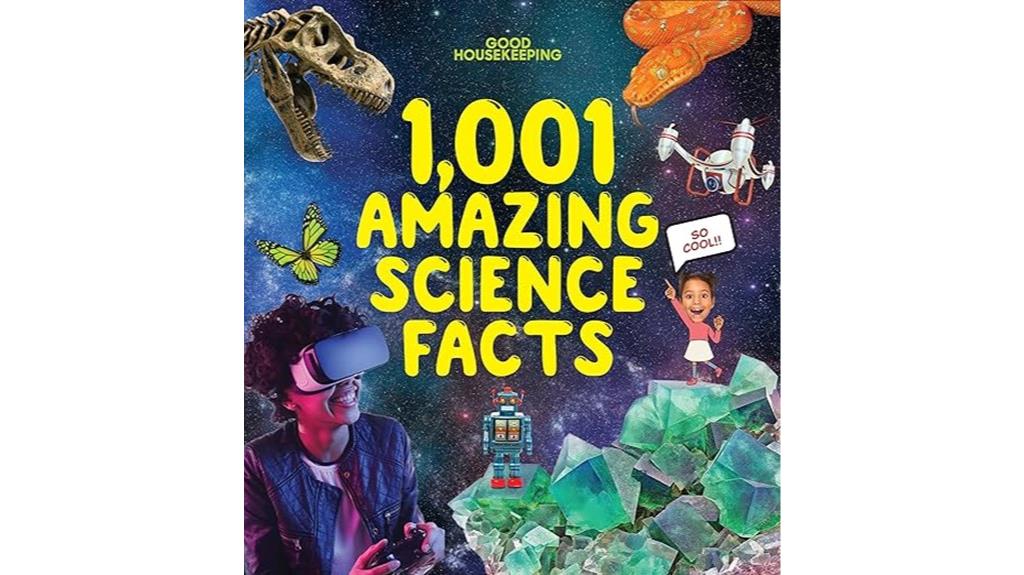
For kids ages 7 to 11, “Good Housekeeping 1,001 Amazing Science Facts” stands out as a fantastic resource packed with intriguing information. I’ve seen my grandsons, aged 8 and 10, absolutely captivated by its well-illustrated pages. The simple explanations make complex concepts easy to grasp, and I love how even adults find the facts fascinating. It’s the perfect gift for curious kids, arriving in great condition and on time. My granddaughter also enjoyed diving into its surprises. Trust me, this book will spark curiosity and imagination, offering endless opportunities for engaging discussions and fun learning experiences!
Best For: Kids aged 7 to 11 who are curious about science and enjoy engaging with interesting facts.
Pros:
- Engaging and well-illustrated content that captures children’s attention.
- Simple explanations make complex scientific concepts accessible for young readers.
- Positive feedback from both kids and adults, making it a great gift option.
Cons:
- Some advanced vocabulary may require adult supervision for younger readers.
- Not suitable for very young children under 7, as some facts might be too complex.
- Limited appeal for older children who may seek more in-depth scientific material.
Human Anatomy for Kids: A Junior Scientists Guide

Human Anatomy for Kids: A Junior Scientist’s Guide is perfect for young explorers aged 5-8 who are keen to learn about their bodies. I love how this book presents complex concepts in a friendly way, making it engaging for kids. The information is organized by body functions, and the illustrations help clarify what they read. Even younger children grasp the content, which is impressive! While it doesn’t cover every detail, it sparks curiosity and fosters understanding. A few copies may arrive damaged, but it remains a fantastic resource for budding scientists excited to explore human anatomy.
Best For: Young explorers aged 5-8 who are eager to learn about human anatomy in an engaging way.
Pros:
- Provides educational content that is both accessible and challenging for young readers.
- Organized by body functions with clear descriptions and helpful illustrations.
- Sparks curiosity and fosters understanding of human anatomy, making it suitable even for younger children.
Cons:
- Some copies may arrive damaged due to the soft cover material.
- Does not cover every detail of human anatomy, potentially leaving older children wanting more in-depth information.
- Lack of pronunciation guides for certain terms may hinder the reading experience.
National Geographic Kids Science Encyclopedia
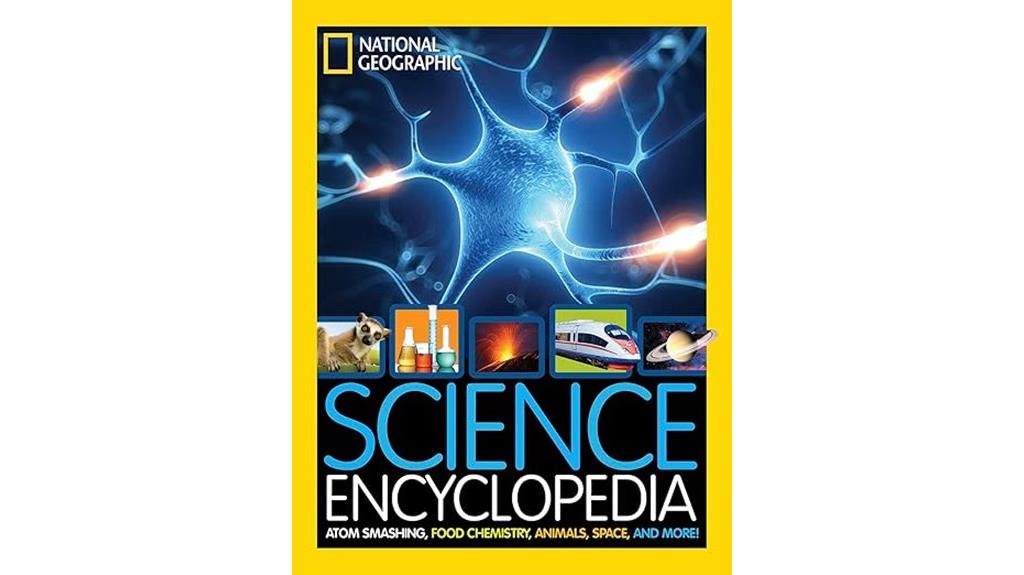
The National Geographic Kids Science Encyclopedia is an excellent choice for curious kids ages 9-12 who want to explore the wonders of science. I love how it covers a range of topics, from the solar system to animals, making every page a new adventure. The colorful layout and engaging visuals keep me interested, and the bubble boxes make reading easier. It’s not just fun; it helps me learn complex concepts too. Many kids, even younger ones, enjoy it, and I’ve heard parents rave about how it supplements school learning. I often find myself reading it at bedtime—it’s simply enthralling!
Best For: Curious kids ages 9-12 who want to explore the wonders of science through engaging visuals and informative content.
Pros:
- Covers a wide range of scientific topics, making learning diverse and exciting.
- Engaging visuals and a colorful layout enhance interest and understanding.
- Encourages repeated reading and exploration, supplementing school education effectively.
Cons:
- May be too advanced for some younger readers, particularly those under 8.
- The abundance of information might overwhelm some kids looking for simpler content.
- Limited to science topics, which might not appeal to all children’s interests.
Awesome Kitchen Science Experiments for Kids
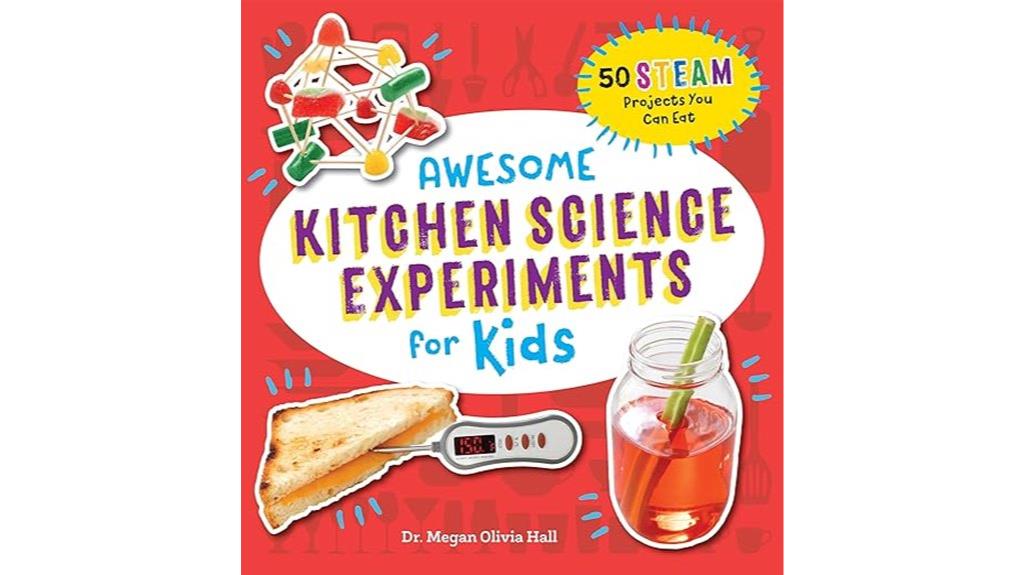
Kids who love both cooking and science will find “Awesome Kitchen Science Experiments for Kids” to be an exciting treasure trove of edible projects. I bought this book for my 6-year-old grandson’s birthday, and it’s been a hit! With 50 engaging STEAM projects suitable for ages 3-8, it balances fun and learning perfectly. Each experiment lists ingredients and tools, making prep a breeze. I appreciate the difficulty ratings, which help us choose wisely. Even if the kids don’t grasp all the science, they’re thrilled to create glow-in-the-dark foods and chocolate fossil molds. It’s a fantastic gift for aspiring young chefs!
Best For: Kids ages 3-8 who enjoy cooking and science, and for parents or caregivers looking for engaging educational activities.
Pros:
- Provides 50 fun and engaging STEAM projects that are edible, enhancing learning through creativity.
- Includes clear ingredient and tool lists, making preparation easy for adults.
- Offers difficulty and mess level ratings, allowing families to select suitable experiments based on their preferences.
Cons:
- Requires significant adult supervision and assistance, especially for younger children.
- Not designed for kids to follow independently, limiting their autonomy in the kitchen.
- Some users wished for more pictures to accompany the experiments for visual guidance.
Factors to Consider When Choosing Kids’ Science Books

When I choose science books for kids, I look for a few key factors. Age appropriateness is essential, along with visual appeal and how engaging the content is. I also consider the variety of topics and whether the book includes practical activities to spark curiosity.
Age Appropriateness
Choosing the right science book for a child shouldn’t be a guessing game. Age appropriateness is vital because it guarantees content is engaging and understandable. Typically, books are categorized by age ranges like 4-6, 6-8, and 9-12 years. For younger readers, simpler vocabulary and vibrant illustrations keep their interest alive, while older kids can grapple with more complex ideas. It’s important to take into account the child’s developmental stage; younger ones thrive with interactive elements, while older children crave in-depth knowledge. Additionally, every child is unique, so I always recommend factoring in their individual reading levels and interests. This way, you’ll foster their curiosity and make reading a truly enjoyable and educational experience.
Visual Appeal
Finding the right science book for a child is only part of the equation; visual appeal plays a significant role in keeping them engaged. Colorful illustrations, engaging photographs, and vibrant layouts grab their attention and spark curiosity about scientific concepts. I look for books that present information in digestible formats, like bubble boxes or infographics, making complex ideas more accessible and enjoyable. High-quality visuals enhance learning and help kids remember facts by associating them with images. For visual learners, illustrations and diagrams cater to their preferences, ensuring they connect with the content effectively. Plus, well-structured visual elements, such as thematic color coding, make exploring topics easier, promoting exploration and independent learning.
Engagement Level
Engagement level is key in selecting kids’ science books, as it can ignite their curiosity and drive them to explore scientific ideas. I’ve found that books blending storytelling with factual information capture attention, making complex topics relatable and fun. Colorful illustrations and diagrams are essential; they not only maintain interest but also help explain scientific concepts clearly.
Interactive elements like hands-on experiments or thought-provoking questions greatly enhance engagement, allowing kids to actively participate in their learning journey. Plus, using age-appropriate language and relatable examples keeps the material accessible and stimulating for young minds. When kids feel connected to what they’re reading, they’re more likely to ask questions and seek answers, fostering a lifelong love for science.
Content Variety
When looking for kids’ science books, content variety plays an essential role in sparking their curiosity. I always seek books that cover diverse topics like chemistry, physics, biology, and astronomy. This way, children can explore different fields and find what truly interests them. I also look for books that weave storytelling into scientific concepts, making complex ideas relatable and memorable. Visual elements like colorful illustrations and diagrams grab their attention and enhance understanding, especially for younger readers. It’s vital to find a mix of simple foundational knowledge and more advanced concepts to cater to various age groups. This approach guarantees that every child can engage with the material, no matter their reading level or prior knowledge.
Practical Activities
While browsing for kids’ science books, I always look for those that include practical activities. Hands-on experiments really engage my child and make learning exciting. I appreciate books with clear instructions and materials lists, as they make preparation a breeze. It’s great to find titles that offer a variety of project difficulties and durations, allowing us to choose activities suited for my child’s age and skill level. I also love books that use common household items; it keeps science accessible and encourages us to try experiments frequently at home. Plus, engaging activities blending fun, like cooking or creative projects, spark my child’s interest and create memorable experiences we can enjoy together as a family.
Educational Depth
Choosing kids’ science books requires careful consideration of their educational depth to guarantee they meet my child’s needs. I look for books that match my child’s age and reading level, presenting complex concepts in an accessible way. A balance of engaging visuals and informative text enhances comprehension, making scientific principles relatable and memorable. I also appreciate books that include hands-on experiments, as they promote active learning and help my child apply what they’ve read. Additionally, I prefer books that cover various topics like biology, physics, and chemistry, fostering broader interests. Clear explanations of scientific principles, coupled with real-world applications and relatable examples, deepen my child’s understanding and spark their curiosity about the world.
Frequently Asked Questions
What Age Group Are These Science Books Suitable For?
I’d say these science books cater to kids aged 5 to 12. Younger children can enjoy the colorful illustrations and simple concepts, while older kids will appreciate the deeper insights and challenges. I love how these books engage different age groups, ensuring everyone finds something intriguing. It’s amazing to see kids of various ages spark their curiosity and imagination through science, and I find it’s never too early to start exploring!
How Can I Encourage My Child to Read These Science Books?
Have you ever watched a child’s eyes light up with discovery? I’ve found that the best way to encourage my child to read science books is to make it an adventure. I create a cozy reading nook, pick engaging titles together, and discuss the fascinating topics they explore. I also share my own excitement about science, sparking curiosity. When they see my enthusiasm, they’re more likely to plunge into those pages themselves!
Are There Any Interactive Components in These Science Books?
I’ve noticed that many science books for kids include interactive components that really engage young readers. Some have fun experiments to try at home, while others feature quizzes or puzzles that make learning exciting. I love how these elements spark curiosity and encourage kids to explore. It’s like combining reading with hands-on activities, which keeps my child enthusiastic to learn more. So, yes, there are definitely interactive parts that can enhance the experience!
Can These Books Be Used for School Projects or Assignments?
Absolutely, I’ve found that these books can be incredibly useful for school projects or assignments. They not only provide engaging information but also often include hands-on activities that enhance learning. When I’ve used them, I noticed how they spark creativity and critical thinking. Plus, their visuals and explanations make complex concepts easier to grasp, which is a huge help when tackling those school tasks. You’ll definitely find them valuable for any project!
Where Can I Purchase These Recommended Science Books?
If you’re looking to purchase those recommended science books, I’ve found some great options. You can check out local bookstores or major retailers like Amazon and Barnes & Noble. I’ve also had success at online platforms such as Book Depository and independent bookstores that offer shipping. Don’t forget to explore your local library too; they often have fantastic science books available for borrowing. Happy reading!
Conclusion
So, are you ready to release your child’s inner scientist? With these incredible books, curiosity and imagination are just a page away. Imagine the joy of seeing their eyes light up with each new discovery! Whether they’re mixing kitchen ingredients or diving deep into human anatomy, each book is a doorway to adventure. Don’t wait too long—grab one (or a few!) and watch them explore the wonders of science like never before. Exciting discoveries await!
